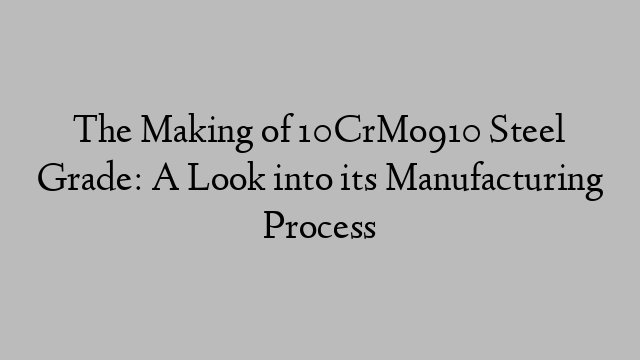Address
304 North Cardinal St.
Dorchester Center, MA 02124
Work Hours
Monday to Friday: 7AM - 7PM
Weekend: 10AM - 5PM
Address
304 North Cardinal St.
Dorchester Center, MA 02124
Work Hours
Monday to Friday: 7AM - 7PM
Weekend: 10AM - 5PM

In order to understand the manufacturing process of 10CrMo910 steel grade, it is essential to examine its chemical composition, mechanical properties, and other specifications.
Chemical Composition:
10CrMo910 is a low alloy steel grade primarily used in the construction of pressure vessels and boilers. It is designed to withstand high temperatures and pressures, making it suitable for applications in the oil and gas industry. The chemical composition of 10CrMo910 typically includes the following elements:
– Carbon (C): 0.08-0.15%
– Silicon (Si): 0.35% maximum
– Manganese (Mn): 0.40-0.70%
– Phosphorus (P): 0.025% maximum
– Sulfur (S): 0.010% maximum
– Chromium (Cr): 2.00-2.50%
– Molybdenum (Mo): 0.90-1.15%
The combination of chromium and molybdenum provides 10CrMo910 with excellent corrosion resistance and high-temperature strength.
Mechanical Properties:
The mechanical properties of 10CrMo910 steel grade play a crucial role in determining its suitability for specific applications. The following are typical mechanical properties of this steel grade:
– Yield Strength: ≥ 280 MPa
– Tensile Strength: 450-600 MPa
– Elongation: ≥ 17%
– Impact Toughness: ≥ 35 J/cm²
– Hardness: ≤ 197 HB
The high yield strength and tensile strength of 10CrMo910 make it capable of withstanding high pressure and temperature conditions. Additionally, its excellent impact toughness ensures it can resist sudden shocks or vibrations.
Manufacturing Process:
The manufacturing process of 10CrMo910 involves several steps to achieve the desired chemical composition, microstructure, and mechanical properties. Here is a basic overview of the manufacturing process:
1. Melting: The raw materials, including iron, carbon, and alloying elements, are melted together in an electric arc furnace or a basic oxygen furnace.
2. Refining: The molten steel is further refined using techniques like ladle metallurgy and vacuum degassing to remove impurities and adjust the chemical composition as per specifications.
3. Casting: The refined steel is then cast into various shapes such as slabs, billets, or blooms using continuous casting or ingot casting methods.
4. Rolling: The casted steel is subjected to hot rolling, where it is passed through a series of rollers to reduce its thickness and create the desired shape.
5. Heat Treatment: The rolled steel is then subjected to heat treatment processes like normalizing or quenching and tempering to enhance its mechanical properties and improve its microstructure.
6. Inspection and Testing: The manufactured 10CrMo910 steel grade undergoes rigorous inspection and testing to ensure it meets the desired chemical composition and mechanical properties. This includes tests like chemical analysis, tensile testing, impact testing, hardness testing, and microstructure analysis.
7. Final Processing: After passing all required tests, the steel can be subjected to additional processes like machining, surface treatment, or coating, depending on its intended application.
In summary, the manufacturing process of 10CrMo910 steel grade involves the precise control of chemical composition, along with various heat treatment and testing processes to achieve the desired mechanical properties and ensure its suitability for high-pressure and high-temperature applications.
10CrMo910 Steel grade
1698236419